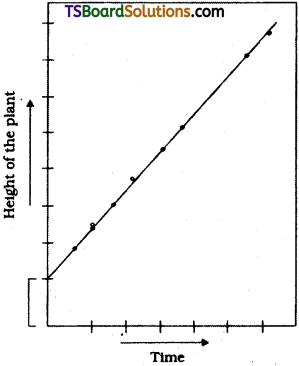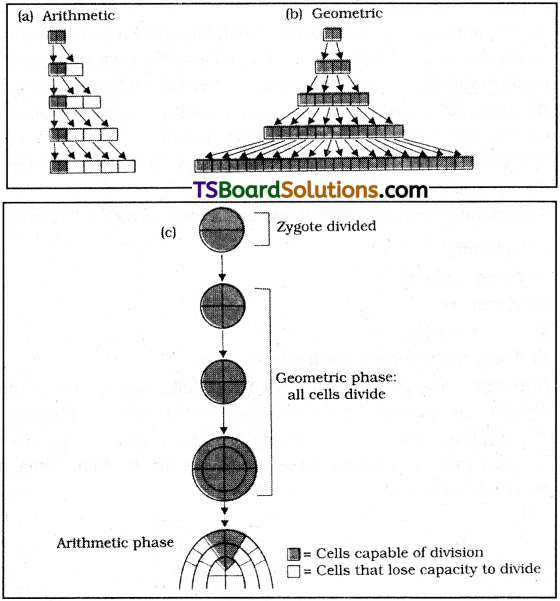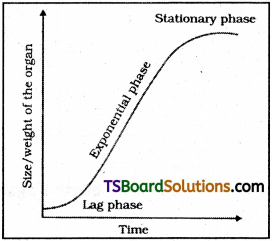Telangana TSBIE TS Inter 2nd Year Botany Study Material 6th Lesson Plant Growth and Development Textbook Questions and Answers.
TS Inter 2nd Year Botany Study Material 6th Lesson Plant Growth and Development
Very Short Answer Type Questions
Question 1.
Define plasticity. Give an example.
Answer:
- Plasticity is the ability of plants to follow different pathways in response to the environment or phases of life to form different kinds of structures.
- Heterophylly is an example of plasticity.
Question 2.
What is the disease that formed the basis for the identification of gibberellins in plants? Name the causative fungus of the disease.
Answer:
- “Bakane” (foolish seedling) disease of rice seedlings.
- It is caused by a fungal pathogen Gibberella fujikuroi.
Question 3.
What is apical dominance? Name the growth hormone that causes it.
Answer:
- Apical dominance : The growing apical bud inhibits the growth of lateral (axillary) buds.
- It is caused by Auxins.
Question 4.
What is meant by bolting ? Which hormone causes bolting?
Answer:
- Bolting : Elongation of internodes just prior of flowering in plants with rosette habit (Eg : Beat, Cabbage).
- Gibberellins are responsible for bolting.
Question 5.
Define respiratory climactic. Name the PGR associated with it.
Answer:
- The rise in the rate of respiration during the ripening of the fruits is known as respiratory climatic.
- Ethylene is responsible for it.
![]()
Question 6.
What is ethephon? Write its role in agricultural practices.
Answer:
- Ethephon in an aqueous solution. It is readily absorbed and transported within the plant and releases ethylene slowly.
- Ethephon hastens fruit ripening in tomatoes and apples and accelerates abscission in flowers and fruits. It also promotes female flowers in cucumbers and thereby increasing the yield.
Question 7.
Which of the PGR (Plant Growth Regulator) is called stress hormone and why?
Answer:
- Abscisic acid (ABA) is called as the stress hormone.
- It stimulates the closure of stomata in the epidermis and increases the tolerance of plants to various kinds of stresses.
Question 8.
What do you understand by vernalisation? Write its significance.
Answer:
- Vernalisation is the method of inducing early flowering in plants by pre-chilling treatment of their seeds or young shoots.
- Vernalization of winter varieties of wheat, barley and rye useful to early harvesting of crop.
Question 9.
Define the terms quiescence and dormancy.
Answer:
- Quiescence is the condition of a seed which is unable to germinate only because favourable external conditions normally required for growth are not present.
- Dormancy is the condition of a seed when it fails to germinate because of internal conditions, even though external conditions are suitable.
Short Answer Type Questions
Question 1.
Write a note on agricultural/horticultural applications of auxins. [Mar. ’17,’14; May ’14]
Answer:
- Auxins help to initiate rooting in stem cuttings, an application widely used for plant propagation in horticulture.
- Auxins promote flowering e.g. in pineapples.
- Auxins help to prevent fruit and leaf drop at early stages but promote the abscission of older mature leaves and fruits.
- Removal of shoot tips usually results in the growth of lateral buds. This is widely applied in tea plantations.
- Auxins also induce parthenocarpy. e.g. in tomatoes.
- Auxins (2, 4D) are widely used as herbicides.
- Auxins control xylem differentiation and help in growth.
![]()
Question 2.
Write the physiological responses of gibberellins in plants. [Mar. 2019]
Answer:
- Gibberellins promote bolting (internode elongation just before flowering) in beet, cabbages and many plants with rosette habit.
- The ability to cause an increase in the length of axis is used to increase the length of grapes stalks.
- Gibberellins cause fruits like apple to elongate and improve their shape.
- Gibberellins delay senescence. Thus, fruits can be left on the tree longer so as to extend the market period.
- GA3 is used to speed up the malting process in brewing industry.
- Spraying Gibberellins on sugarcane crop increases the length of the stem, thus increasing the yield by as much as 20 tonnes per acre.
- Spraying juvenile conifers with Gibberellins fastens the maturity period, thus leading to early seed production.
Question 3.
Write any four physiological effects of cytokinins in plants. [Mar. ’18, May ’17]
Answer:
- Cytokinins have specific effects on cytokinesis (that means division of cytoplasm during cell division). It helps in occuring rapid cell division for example: root apices, developing shoot buds, young fruits etc.
- Cytokinins help to produce new leaves, chloroplasts in leaves, lateral shoot growth and adventitious shoot formation.
- Cytokinins help to overcome the apical dominance.
- Cytokinins promote nutrient mobilisation which helps in the delay of leaf senescence.
Question 4.
What are the physiological processes that are regulated by ethylene in plants? [Mar. 2020]
Answer:
- Ethylene accelerates the ripening of fruits. It is regarded as fruit ripening hormone.
- Effects of ethylene on plants include horizontal growth of seedlings, swelling of the axis and apical hook formation in dicot seedlings.
- Ethylene promotes senescence and abscission of plant organs, especially of leaves and flowers.
- Ethylene breaks seed and bud dormancy. It initiates germination in peanut seeds and sprouting of potato tubers.
- Ethylene promotes rapid internode/petiole elongation in deep water rice plants.
- Ethylene helps leaves/upper parts of the shoot to remain above water.
- Ethylene promotes root growth and root hair formation, thus helping plants to increase their absorption surface.
- Ethylene is used to initiate flowering and for synchronising fruit – set in pineapples. It also induces flowering in mango.
Question 5.
Write short notes on seed dormancy.
Answer:
- Dormancy is the condition of seed when it fails to germinate because of internal conditions, even though external conditions (e.g. temperature, moisture) are suitable.
- The dormancy may be caused by hard seed coats that prevents uptake of oxygen or water (e.g. fabaceae).
- Dormancy caused by hard seed coats can be broken by scarification.
- Seeds of certain plants (e.g.: tomato) contain chemical compounds, which inhibit their germination.
- Many seeds (e.g.: Polygonum) will not germinate untill they have been exposed to low temperatures in moist conditions in the presence of oxygen for weeks to months.
- Motet seeds respond to high temperatures and several seeds respond best when daily temperatures alternate between high and low.
![]()
Question 6.
Which one of the plant growth regulators would you use if you are asked to
a) Induce rooting in a twig
b) QCiickly ripen a fruit
c) Delay leaf senescence
d) Induce growth in axillary buds
e) ‘Bolt’ a rosette plant
f) Induce immediate stomatal closure in leaves
g) Overcome apical dominance
h) Kill dicotyledonous weeds.
Answer:
a) Auxins like IBA, NAA
b) Ethylene
c) Cytokinin
d) Cytokinins
e) Gibberellins
f) Abscisic acid (ABA)
g) Cytokinins
h) Auxins (2-4 D)
Long Answer Type Questions
Question 1.
Define growth, differentiation, development, dedifferentiation, redifferentiation, determinate growth, meristem and growth rate.
Answer:
1) Growth :
Growth is defined as a permanent or irreversible increase in dry weight, size, mass or volume of a cell, organ or organism.
2) Differentiation :
The cells derived from root apical and shoot-apical meristems and cambium differentiate and mature to perform specific functions. This act leading to maturation is termed as differentiation.
3) Dedifferentiation :
The living differentiated cells, that have lost the capacity to divide, can regain the capacity of division under certain conditions. This phenomenon is called dedifferentiation, e.g.: Formation of meristems – interfascicular cambium and cork cambium from parenchyma cells.
4) Redifferentiation :
In the process of redifferentiation meristems/tissues are able to divide and produce cells that once again lose the capacity to divide but mature to perform specific functions. That means they get redifferentiation.
5) Determinate growth :
Leaves are specialised organs characterised by defined developmental destiny and determinate growth.
6) Meristem :
It is located at root and shoot tips. The meristem refers to the cells that remain dividing.
7) Growth rate :
Increased growth per unit time is termed as growth rate.
![]()
Question 2.
Describe briefly
a) Arithmetic growth
b) Geometric growth
c) Sigmoid growth curve
d) Absolute and relative growth rates
Answer:
a) Arithmetic growth :
In arithmetic growth, following mitotic cell division, only one daughter cell continues to divide while the other differentiates and matures.
The simplest expression of arithmetic growth is exemplified by a root elongating at a constant rate. On plotting the length of the organ against time, a linear curve is obtained. Mathematically, it is expressed as

Constant linear growth, a plot of length L against time t
L1 = L0 + rt
L1 = Length at time’t’
L0 = Length at time ‘zero’
r = growth rate/elongation per unit time.
b) Geometric growth :
In several systems, the initial growth is slow (lag phase). Growth increases rapidly thereafter at an exponential rate (log or exponential phase) S – curve is observed

Diagrammatic representation of: (a) Arithmetic (b) Geometric growth and (c) Stages during embryo development showing geometric and arithmetic phases
c) Sigmoid curve growth :
A sigmoid curve is a characteristic of living organism growing in a natural environment. It is typical for all cells, tissues and organs of a plant.

An idealised sigmoid growth curve typical of cells in culture, and many higher plants and plant organs
It consists of 3 phases namely
(a) Lag phase
(b) log phase
(c) Stationary phase
d) Absolute and relative growth rate :
Measurement and comparison of the total growth per unit time is called the absolute growth rate.
The growth of the given system per unit time expressed on a common basis e.g. per unit initial parameter is called the relative growth rate.
Question 3.
List five natural plant growth regulators. Write a note on discovery, physiological functions an agricultural/horticultural applications of any one of them.
Answer:
| Plant Growth regulators | Discovery | Physiological function and agricultural/horticultural application |
| 1. Auxins e.g.: 2AA, 2BA NAA, 2-4D. |
Discovered by F.W. Went from coleoptile of Avena sativa. | They promote stem growth by cell elongation. They stimulate root growth at very low concentration and are involved in apical dominance and tropism Auxins promote flowering. e.g.: in pineapples. |
| 2. Gibberillins e.g.: GA, GA2 &GA3 |
Yabuta and Sumiki isolated crystalline gibberellin from the fungus. | They promote stem growth of the internodes by cell elongation and break seed dormancy. They are involved in germination of seeds. GA3 is used to speed up malting in brewing industry. |
| 3. Cytokinins e.g. Zeatin |
Letham (1963) isolated naturally occurring cytokinin in pure crystalline form from immature Maize seeds. | They interact with auxins in apical meristem but promote lateral bud growth. It is necessary for cytokinesis. It retards senescence. It induces femaleness in flowers. |
| 4. Abscisic acid (ABA) e.g.:Dormin |
Carns, Addicott and co-workers isolated abscisic acid from immature cotton fruits. | It inhibits cell division and growth in stem and root. It promotes dormancy in both buds and seeds also. It induces parthenocarpy in rose. |
| 5. Ethylene, a gaseous hormone (CH2 = CH2) | Ethylene is a fruit ripening hormone. Ethylene is used to initiate flowering and for synchronising fruit-set in pineapples. It also induces flowering in Mango. |
Note : Write any one of the above.
Intext Question Answers
Question 1.
Fill in the blanks with appropriate word/words.
a) The phase in which growth is most rapid is …………… .
b) Apical dominance as expressed in dicotyledonous plants is due to the presence of more …………… in the apical bud than in the lateral ones.
c) In addition to auxin, a ………….. must be supplied to the culture medium to obtain a good callus in plant tissue culture.
d) …………… of vegetative plants are the sites of photoperiodic perception.
Answer:
a) Log phase
b) Auxins
c) Cytokinins
d) Shoot apex of plant
![]()
Question 2.
A primary root grows from 5 cm to 19 cm in a week. Calculate the growth rate and relative growth rate over the period.
Answer:
Growth rate is = \(\frac{19-5}{7}=\frac{14}{7}\) = 2 cm
Question 3.
Gibberellins promote the formation of ………….. flowers on genetically …………… plants in Cannabis whereas ethylene promotes formation of …………. flowers on genetically …………… plants.
Answer:
a) male
b) dwarf
c) female
d) dwarf
Question 4.
Classify the following plants into Long day plants (LDP), Short day plants (SDP) and Day neutral plants (DNP)
Xanthium, Spinach, Henbane (Hyoscyamus niger), Rice, Strawberry, Bryophyllum, Sunflower, Tomato, Maize.
Answer:
Xanthium – Short day plant
Spinach – Long day plant
Henbane – Short day plant
Rice – Short day plant
Strawberry – Short day plant
Bryophyllum – Short day plant
Sunflower – Day neutral plant
Tomato – Day neutral plant
Maize – Long day plant
Question 5.
A farmer grows cucumber plants in his field. He wants to increase the number of female flowers. Which plant growth regulator can be applied to achieve this?
Answer:
Auxins.
Question 6.
Where are the following hormones synthesized in plants?
a) IAA
b) Gibberellins
c) Cytokinins
Answer:
a) Shoot apex and to some extent root apex also contribute to the synthesis of auxins.
b) Gibberellins are synthesised from Acetyl co enzyme A. They are mostly synthesized in apical tissues. They also synthesised in developing seeds, fruits, young leaves of developing apical bud, and elongation shoots.
c) Natural cytokinin are synthesised in the regions where rapid cell division occurs for example root apices, developing shoot buds, young fruits, etc.
Question 7.
Light plays an important role in the life of all organisms. Name any three physiological processes in plants which are influenced by light.
Answer:
- Photosynthesis
- Photoperiodism
- Growth
![]()
Question 8.
Growth is one of the characteristics of all living organisms. Do unicellular organisms also grow? If so, what are the parameters?
Answer:
Yes. If we plot the parameter of growth against time, we get a typical sigmoid or . S-curve.
Question 9.
Rice seedlings infected with fungus Gibberella fujikuroi are called foolish seedlings. What is the reason?
Answer:
The reason is the rice plants grew excessively tall and very little grain production. The plants were taller, thinner, and paler with little tillering as compared to healthy plants.
Question 10.
Why isn’t any one parameter good enough to demonstrate growth throughout the life of a flowering plant?
Answer:
Because growth depends upon cell division, nutrient supply, time, etc.
Question 11.
‘Both growth and differentiation in higher plants are open.’ Comment.
Answer:
Plants retain the capacity for unlimited growth throughout the life due to the presence of meristems at certain locations of their body. The cells of such meristems have the capacity to divide and self perpetite. The product, however, soon loses the capacity to divide and such cells make up plant body.
This form of growth where in new cells are always being added to the plant body by the activity of the meristem is called the open form of growth.
The cells divided from root apical and shoot apical meristems and cambium differentiate the nature to perform specific functions. It is called differentiation.
Differentiation in plants is open because cells/tissues arising out of the same meristems have different structures at maturity. The final structure at maturity of cell tissue is also determined by the location of the cell with in.
Question 12.
‘Both a short day plant and a long day plant can produce flowers simultaneously in a given place.’ Explain.
Answer:
A long day plant required the exposure to light for a period exceeding well defined critical duration while short day plant must be exposed to light for a period less than this critical duration before the flowering is initiated in them. It means that not only the duration of light but also the duration of dark period is of equal importance. Hence flowering depends not only a combination of light and dark exposure but also their relative durations.
That is why, both a short day and a long day plant produce flowering simultaneously in a given place when they are exposed to necessary inductive photoperiod required by them in artificial condition.
Question 13.
Would a defoliated plant respond to photoperiodic cycle? Why?
Answer:
No, a defoliated plant would not respond to photoperiodic cycle. Because the site of perception of light/dark duration is the leaves. In defoliated plants leaves are absent.
It has been hypothesised that there is a hormonal substances that is responsible for flowering. This hormonal substance migrates from leaves to shoot apices for inducing flowering only when the plants are exposed to the necessary inductive photoperiod.
![]()
Question 14.
What would be expected to happen if
(1) GA3 is applied to rice seedlings.
(2) Dividing cells stop differentiating.
(3) A rotten fruit gets mixed with unripe fruits
(4) You forget to add cytokinin to the culture medium
Answer:
(1) Elongation of coleoptile occurs quickly.
(2) Undifferentiated mass of cells are formed.
(3) All the fruits will be mature.
(4) Shoot growth is inhibited.